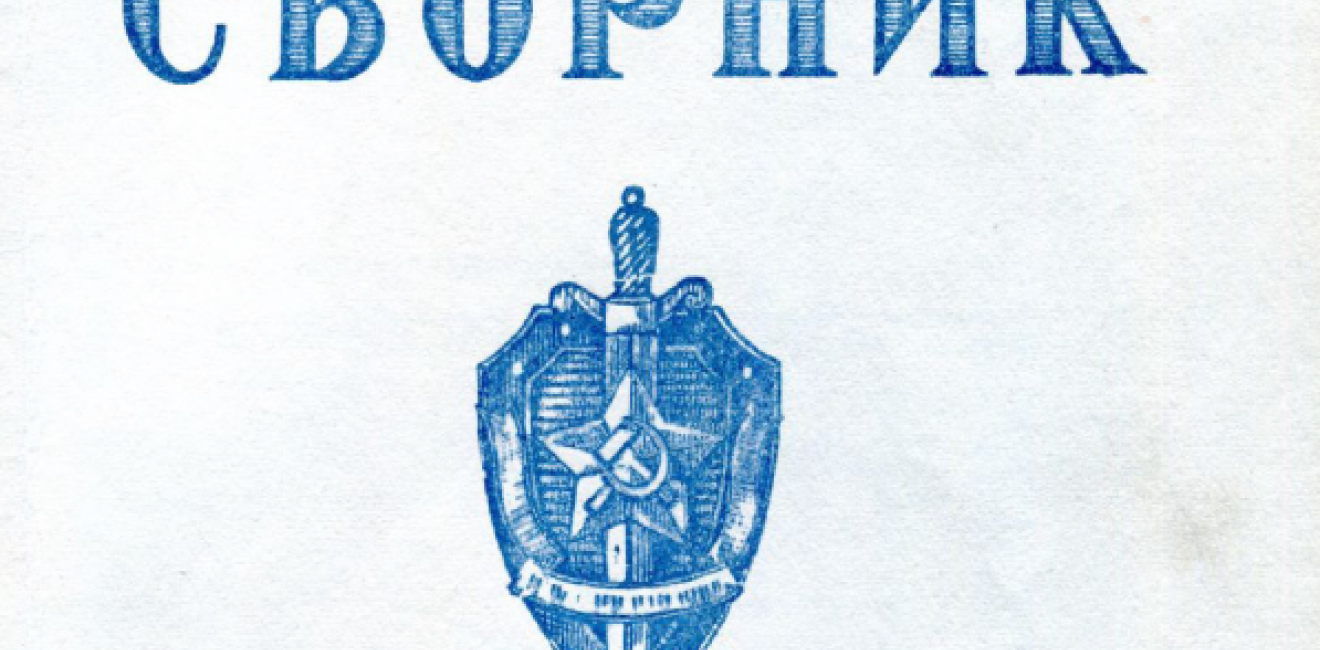In the early 1980s, Major General Vladimir Safronov was the head of the KGB directorate in the Chita region in Siberia bordering the People’s Republic of China. In 1984, he published a report in the top secret KGB in-house journal Sbornik about how his directorate had caught a Soviet citizen recruited by the Chinese Ministry of Public Security to act as their sleeper agent in the Soviet Union.[1]
Despite that more than 30 years have elapsed since the collapse of the Soviet Union and the dissolution of the KGB, Sbornik has never been officially declassified by the Russian government and is still considered a state secret in Putin’s Russia. However, many of Sbornik’s issues were recently digitized by the Genocide and Resistance Research Centre of Lithuania and are available to researchers.[2]
This is the first discussion of Safronov’s report in English. Safronov’s article is of particular value to intelligence history, not only because it sheds additional light on the little explored aspects of the Soviet-Chinese spy wars during the Cold War, but also because it demonstrates how the KGB coordinated both its investigative and operative branches in counterintelligence work.
In his report, Safronov described how on August 9, 1981, an unknown individual illegally crossed from Soviet territory into the People’s Republic of China. The individual went undetected by the KGB border guards in the Chita region. Safronov then stated that, about a year later, on July 21, 1982, a young man approached a policeman in the village of Gazimursky Zavod (more than 100 km from the Chinese border) and asked about the location of the local KGB headquarters. The young man identified himself to the KGB officers on duty as Petrov. He said that he was the person who had illegally crossed into China in August 1981. He confessed that while living in China, he was recruited and trained by the Chinese Ministry of Public Security and was sent back to the Soviet Union as a sleeper agent. However, he decided to turn on his Chinese handlers and was now willing to work as a KGB informer.
Safronov wrote that though Petrov was promptly arrested and charged with illegal border crossing, the KGB counterintelligence began seriously considering his proposal to act as a double agent in the deception operation against China.
However, at the same time, according to Safronov, there were some signs which called for the KGB to exercise a certain amount of caution. For instance, the KGB investigative branch had determined that Petrov, when crossing the border and, also for a few days afterwards, had taken extra care to remain unnoticed. He hid the remains of his food and stayed away from the main roads. In addition, when he arrived in Nerchinsky Zavod, the first Soviet village near the border, he made no attempts to contact the local police or KGB personnel, but, instead, tried to leave the border area as quickly and as clandestinely as possible.
It was at this point in the investigation that, according to Safronov, the KGB investigators requested the assistance of the operative branch. The KGB operatives responded by placing their agent MIRONOV as a stool pigeon in Petrov’s prison cell and tasked him to gain Petrov’s trust. After a while, MIRONOV’s approach worked and Petrov opened up to him. Believing that MIRONOV would soon be released, Petrov put all of his hitherto hidden cards on the table and tried to recruit him to work for the Chinese Ministry of Public Security. He taught MIRONOV how to enter China illegally, told him of the places where the Chinese border guards would wait for him, and even revealed a password to use in communication with them. He also prepared a letter for his Chinese handlers in which he described what had happened to him and advised them of the mistakes that were made during his training.
After MIRONOV informed the KGB operatives of the existence of the letter, Petrov’s cell was searched and the letter was seized. It was then used by the KGB investigators as a smoking gun to force Petrov to make a full confession.
According to Safronov, Petrov admitted to the investigators that he had illegally crossed into China because he was not happy with the political and economic conditions in the Soviet Union. He expected that he would not be sent back to the USSR due to the ongoing political and ideological tensions between the two countries. However, as soon as he entered Chinese territory, he was arrested by the border guards and taken to the border town of Khailar. He was then subject to lengthy interrogations by the officers of the Chinese Ministry of Public Security and asked to provide any information concerning the capabilities of the Soviet military forces both in the border areas and beyond. In particular, Petrov was asked to produce an illustration of all Soviet military facilities in the Chita region as well as the railway transportation networks and even the railway station locations not only in the regional centers of Dauriya and Chita, but also in Irkutsk, Sverdlovsk [Yekaterinburg], and even in Tashkent. Petrov stated that the interrogations lasted for about four months, after which he was tendered an offer to work as an illegal (sleeper) agent of the Ministry of Public Security in the Soviet Union.
Safronov did not say anything about Petrov’s motives to agree to return to the Soviet Union as a spy. In addition, there is nothing in Petrov’s reported testimony to indicate that he was forced into being a spy against his will. Petrov made no mention of any bad treatment while in the hands of the Chinese Ministry of Public Security, though he could have used this as an excuse for his behavior. In other words, it appears that Petrov was treated relatively well and became a willing helper in the PRC’s anti-Soviet intelligence activities.
Petrov stated that after he agreed to become a spy, he was assigned a codename XIE HUA and transferred to a small town southwest of Beijing where he lived in a safe house while undergoing intelligence training for the next six months.
By the summer of 1982, the contours of his intelligence assignment were clear. He was to return to the Soviet Union illegally and leave the border area as quickly as possible. He was then to contact his mother to find out whether he was still being sought by the KGB and if not, he was to request new identification documents under his real name and try to get a job in the Chita or Irkutsk regions. In the case that the KGB was still looking for him, he was to obtain identification documents under a false name. After getting the documents and settling down, Petrov was to begin collecting information, primarily regarding the Soviet military infrastructure, by visual surveillance and photographing and by contact with the individuals employed in the military sector. He was also to try to recruit associates among those unhappy with the Soviet way of life, including criminals, and if an appropriate candidate came along, to advise him how to get safely across the border to China to act as a liaison. (This is likely what Petrov tried to do with MIRONOV.) In addition to collecting information and recruiting, Petrov was to buy, or steal if necessary, as many Soviet official government documents (civilian and military ID cards and passports, transcripts, diplomas, etc.) and topographical maps as possible.
Particularly interesting was the manner in which Petrov was told to communicate the collected information to his Chinese handlers. He was to use mail correspondence between a certain Mrs. Vesyolova from the Ryazan region and her relatives in China, which was known to the KGB and would not attract any suspicion. While at the safe house near Beijing, Petrov was taught how to imitate Veselyova’s handwriting and memorize a set of coded words to convey his report.
In mid-summer 1982, it was determined by the Ministry of Public Security that Petrov was ready to begin his espionage assignment in the Soviet Union. On July 15, 1982, he was given a fairly large sum of money (3450 rubles)[3] and taken to the river which ran between the two countries. His Soviet clothes were returned to him and he was even treated to a glass of cognac because “the water was cold.” The Chinese border guards did not know it at the time, but they would never see their agent again. Six days later, Petrov approached a Soviet policeman and was arrested.
According to Safronov, after crossing the border, Petrov was able to make the acquaintance of several villagers in the nearby Soviet village of Nerchinsky Zavod. They quickly became his drinking buddies, hid him from the police, and then transported him outside of the border area for 300 rubles. Although he ended up more than 100 km away from the border, Petrov claimed that he realized that he was soon going to get caught and so he decided to take the initiative, turn himself in, and offer to cooperate. In the final twist of the story, however, Petrov admitted that this was exactly what his Chinese handlers advised him to do in such a situation because they hoped that he would then be recruited by the KGB and sent back to China, which would enable them to get acquainted with the KGB requirements and methods.
In the end, the KGB directorate in the Chita region did not fall for the Chinese Ministry of Public Security’s ruse, thanks primarily to the efficient coordination of their investigative and operative capacities. General Safronov enthusiastically shared their positive experience in the pages of the Sbornik with the rest of his Chekist colleagues across the Soviet Union.
As for Petrov, he was convicted of treason for espionage and passing classified military information to a foreign government. Yet, given the classification of his crimes, he received a strangely lenient sentence by the regional military court: only 10 years in prison. Evidently, the Soviet state security apparatus ended up benefitting from his ill-fated attempt at being a Chinese sleeper spy. They learned a lot about the requirements and methods of their opponents and therefore decided not to demand a harsher punishment.
[1] Генерал-майор Владимир Сафронов [Major General Vladimir Safronov], "Инсценировать явку с повинной не удалось [Faking a Confession Failed]," КГБ Сборник 102 (1984): 30-35. Vladimir Safronov (1927-2002) began his work in the Soviet state security apparatus in 1947. He was appointed to head the KGB Directorate of the Chita region in 1979 and remained until 1988 when he retired. His previous position was the chief of the Second [Counterintelligence] Directorate of the Kazakh KGB (1975-1979) where one of his main tasks was to combat Chinese espionage and infiltration. For more information on Safronov, see https://shieldandsword.mozohin.ru/personnel/safronov_v_i.htm. On the Soviet-Chinese spy war on the territory of Kazakhstan in the 1970s, see Filip Kovacevic, “The Soviet-Chinese Spy Wars in the 1970s: What KGB Counterintelligence Knew, Part IV,” Sources & Methods: A Blog of the Wilson Center’s History and Public Policy Program, https://www.wilsoncenter.org/blog-post/soviet-chinese-spy-wars-1970s-what-kgb-counterintelligence-knew-part-iv, June 9, 2021.
[2] See “KGB Journals and Books,” The Genocide and Resistance Research Centre of Lithuania, https://www.kgbdocuments.eu/kgb-journals-and-books/
[3] The average monthly salary in the Soviet Union in 1986 was 200 rubles.







